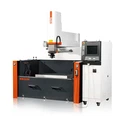Although the principles of EDM machining are the same, there are variations in the process, especially between wired EDM working and sinker EDM working. Both processes have anodes and cathodes used to shape the workpiece to fit the parameters of the produced part. How they complete this process using electrical current is quite different.
With sinker EDM machining, an electrical potential difference is created between the tool and work material, both of which are electrically conductive and submerged in a dielectric fluid such as hydrocarbon oil or deionized water. The spark gap that separates the tool and workpiece is flooded with the dielectric fluid. The created electric field depends on the electric potential difference and the spark gap.
The tool takes the negative terminal while the work material takes the positive terminal of the power generator. Free electrons on the tool are subjected to electrostatic forces the moment the electric field begins. If there is less work function or smaller bonding energy of the electrons, the emission of electrons would be from the tool (assuming that it is connected to the negative terminal). This type of emission of electrons is called cold emission.
Through the dielectric medium, the cold emitted electrons are accelerated towards the work material. As they gain velocity and energy and begin moving towards the work, collisions occur between the electrons and dielectric molecules. The collisions cause the ionization of the dielectric molecules, which depends on the work function or ionization energy of the dielectric molecule and the energy of the electrons. As the electrons accelerate, positive ions and electrons are generated because of the collisions.
This cyclic process increases the electron and ion concentration in the dielectric fluid between the tool and the work material at the site of the spark gap. The concentration becomes so high that the matter in the channel is characterized as "plasma." The electric resistance of the plasma channel is very low. The large number of electrons flux from the tool to the work with ions moving suddenly from the work to the tool. This motion of electrons is known as an avalanche.
The sudden movement of electrons and ions creates the thermal energy of the spark with a heat range of 8,000°C up to 12,000°C. The rapid motion of the electrons hits the work material and the ions on the tool. The impact of the electrons and ions on the surface of the workpiece is converted into thermal energy or heat flux.
The EDM wire machining process, an alternative to sinker EDM machining, works much like a wood band saw using a wire for the cutting process. The wire, made of copper or brass, has a high voltage electrical discharge passed through it that makes it possible for the wire to cut through the thickness of the workpiece.
The wire in EDM wire machining creates a spark in deionized water where conductivity is precision controlled. The water cools the material and washes away the removed material with clean dielectric fluid being constantly pumped into the process to flush the excess waste away.
The extreme temperatures of the EDM process rapidly removes excess material from the workpiece by vaporization and melting or spark erosion. The molten metal is partially removed. As the electric potential is withdrawn, the plasma channel is no longer sustained and generates pressure or shock waves as it collapses. This evacuates the molten material forming a crater of material that is removed from around the spark site.
Material is removed by the formation of shock waves as the plasma channel collapses due to electric potential discontinuation where the work material is made positive and the tool negative. As the electrons strike the workpiece, craters are formed by the heating, melting, and removal of material as positive ions strike the tool resulting in tool wear.
Electrical discharge machining requires a great deal of power. Generators used for the process must be capable of supplying the necessary power in order for the process to run efficiently and successfully. They are selected in accordance with their ability to generate the power parameters of the process.







